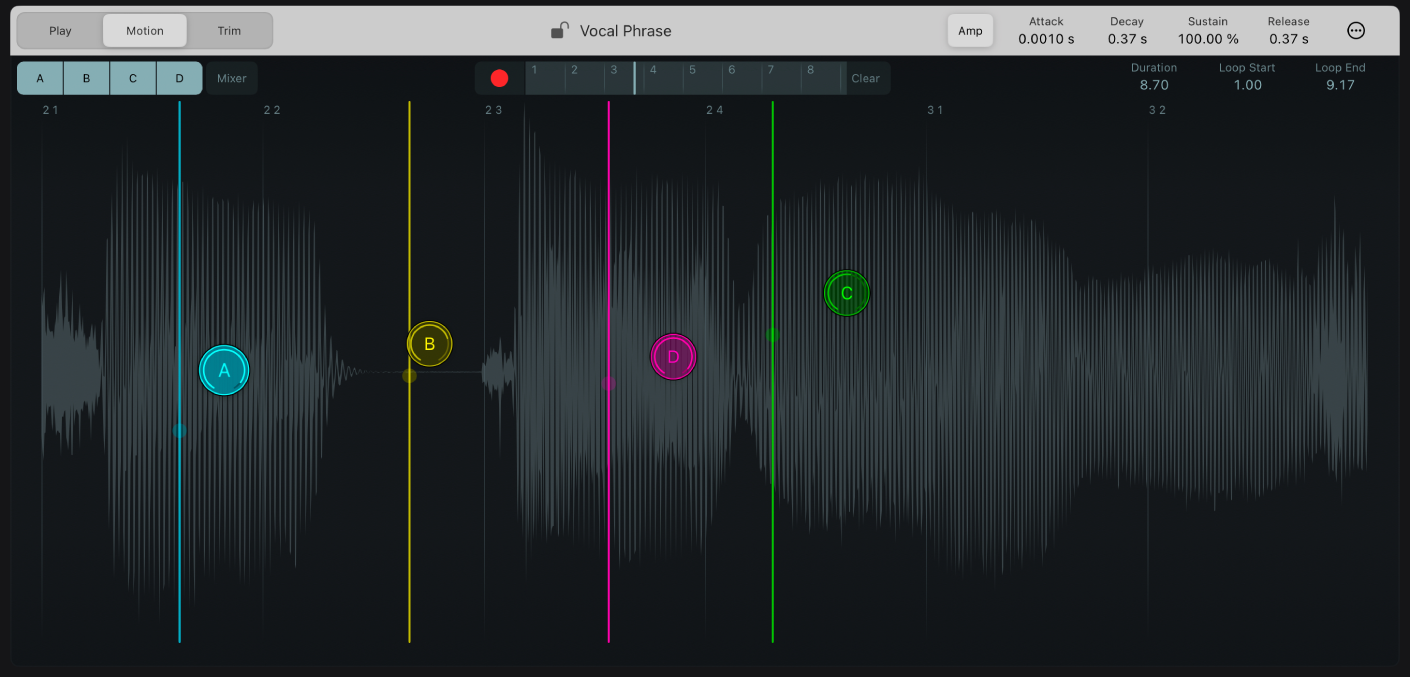Logic Pro User Guide for iPad
- What’s new in Logic Pro 1.1
-
- What is Logic Pro?
- Working areas
- Work with function buttons
- Work with numeric values
-
- Intro to tracks
- Create tracks
- Create tracks using drag and drop
- Choose the default region type for a software instrument track
- Select tracks
- Duplicate tracks
- Reorder tracks
- Rename tracks
- Change track icons
- Change track colors
- Use the tuner on an audio track
- Show the output track in the Tracks area
- Delete tracks
- Edit track parameters
- Start a Logic Pro subscription
- How to get help
-
- Intro to recording
-
- Before recording software instruments
- Record software instruments
- Record additional software instrument takes
- Record to multiple software instrument tracks
- Record multiple MIDI devices to multiple tracks
- Record software instruments and audio simultaneously
- Merge software instrument recordings
- Spot erase software instrument recordings
- Replace software instrument recordings
- Capture your most recent MIDI performance
- Use the metronome
- Use the count-in
-
- Intro to arranging
-
- Intro to regions
- Select regions
- Cut, copy, and paste regions
- Move regions
- Remove gaps between regions
- Delay region playback
- Trim regions
- Loop regions
- Repeat regions
- Mute regions
- Split and join regions
- Stretch regions
- Separate a MIDI region by note pitch
- Bounce regions in place
- Change the gain of audio regions
- Create regions in the Tracks area
- Convert a MIDI region to a Drummer region or a pattern region
- Rename regions
- Change the color of regions
- Delete regions
- Create fades on audio regions
- Access mixing functions using the Fader
-
- Intro to Step Sequencer
- Use Step Sequencer with Drum Machine Designer
- Record Step Sequencer patterns live
- Step record Step Sequencer patterns
- Load and save patterns
- Modify pattern playback
- Edit steps
- Edit rows
- Edit Step Sequencer pattern, row, and step settings in the inspector
- Customize Step Sequencer
-
- Effect plug-ins overview
-
- Instrument plug-ins overview
-
- ES2 overview
- Interface overview
-
- Modulation overview
-
- Vector Envelope overview
- Use Vector Envelope points
- Use Vector Envelope solo and sustain points
- Set Vector Envelope segment times
- Vector Envelope XY pad controls
- Vector Envelope Actions menu
- Vector Envelope loop controls
- Vector Envelope release phase behavior
- Vector Envelope point transition shapes
- Use Vector Envelope time scaling
- Use the Mod Pad
- Modulation source reference
- Via modulation source reference
-
- Sample Alchemy overview
- Interface overview
- Add source material
- Save a preset
- Edit mode
- Play modes
- Source overview
- Synthesis modes
- Granular controls
- Additive effects
- Additive effect controls
- Spectral effect
- Spectral effect controls
- Filter module
- Low and highpass filter
- Comb PM filter
- Downsampler filter
- FM filter
- Envelope generators
- Mod Matrix
- Modulation routing
- Motion mode
- Trim mode
- More menu
- Sampler
- Copyright
Sample Alchemy Motion mode in Logic Pro for iPad
Using Motion mode, you can record the movement of source handles to automate various parameters so that they change over time, producing dynamic and evolving sounds.
After you record a motion sequence, it is automatically looped and remains tempo-synchronized to your project. When you play back the sound, the Motion sequence you recorded is visually replicated on the screen.
Add to your recording by making overdubs or manually setting the Loop Start and Loop End points. If you’re unsatisfied with your recording, you can use the Clear button to erase the motion recording and start over.
Tip: Instead of using Motion mode to record the movement of the handles, you can record it directly to a region. After you record your performance, you can edit the automation captured in the region to suit your project. See Show region automation.

Motion mode parameters
Record button: Tap the Record button (if necessary) to start recording motion. The Record button flashes until you touch the handles or a MIDI input is received. Recording when a recording already exists will cause any additional touches to override that particular section of the recording, in a similar manner to Touch automation.
Clear button: Delete the motion recording. This button only appears after a motion recording has been made.
Timeline: Displays the playback position of the latest note, with beat markers as the axis.
Loop Start: Set the motion playback loop start point in beats.
Loop End: Set the motion playback loop end point in beats.
Duration: Set the duration of the recording in beats. Changing this value will stretch the motion recording and loop start and end positions accordingly.
Record a motion sequence
Tap the Record button to arm the motion recorder (if necessary). The Record button flashes until you touch the handles or a MIDI input is received.
Move the source handles as required for the duration of the recording.
Release the handles to automatically stop the recording, or tap the Stop button.
Tap Record again if you want to overdub the motion recording.
Play a MIDI note to listen to and visualize your motion recording. You can now switch to Play mode if you want. Any movement of the handles shifts your motion recording up/down/left/right.
Download this guide: PDF